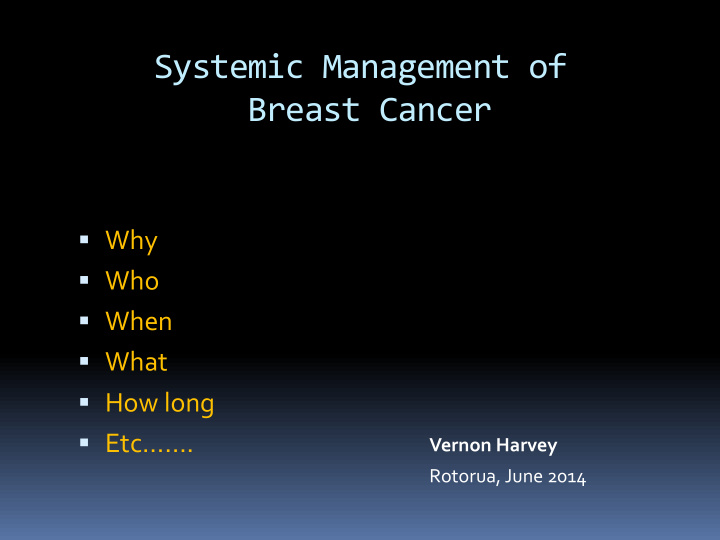



Systemic Management of Breast Cancer Why Who When What How long Etc……. Vernon Harvey Rotorua, June 2014
Systemic Management of Breast Cancer Metastatic Disease Adjuvant Therapy Aims of therapy Aim of therapy Quality of life Enhance cure Prolongation of life Identify ‘best’ therapy
Systemic Management of Breast Cancer Metastatic Disease Adjuvant Therapy Options Options Endocrine therapy Endocrine therapy Chemotherapy Chemotherapy Biological therapy Biological therapy
Systemic Management of Breast Cancer Metastatic Disease Adjuvant Therapy For whom For whom Symptomatic Dependant on baseline risk Fit enough Patient wishes Want therapy
Metastatic Breast Cancer Options But which…. Endocrine therapy Hormones Chemo ER/PR positive Chemo Hormones Chemotherapy Both together Biological therapy HER2 positive Chemo + Biological (if HER2 +)
Metastatic Breast Cancer General Principles Hormone therapy Chemotherapy * (with Herceptin if HER2+) Symptom Control * Some prefer chemotherapy first for life threatening disease
Metastatic Breast Cancer Endocrine Therapy Chemotherapy (ER and/or PR positive) Anthracyclines Tamoxifen Taxanes Ovarian Ablation Capecitabine (premenopausal) Vinorelbine Aromatase inhibitors (postmenopausal) Progestogens Biological Therapy Faslodex (HER2 positive) Trastuzumab (Herceptin) Lapatinib
Metastatic Breast Cancer Endocrine Therapy Chemotherapy (ER and/or PR + only) (ER/PR- or failed hormones) Single drug Single or combination Sequential therapy Sequential therapy Continue to progression Duration limited by toxicity Achievements Control in 30-60% Control in 30-60% Average duration 9- 12 mths Average duration 9-12 mths Wide variation Wide variation
Adjuvant Therapy of Breast Cancer Rationale Disease that appears localised may have spread beyond the breast. Therapy that is only palliative in MBC may eliminate microscopic disease
Adjuvant Therapy of Breast Cancer Options But which…. Hormones (for most ER+) Chemotherapy ( depends on risk) Endocrine therapy ER/PR positive Chemotherapy Biological (with Chemo) Biological therapy (if HER2 +) HER2 positive BUT to whom……..
Adjuvant Therapy of Breast Cancer The Concept of Risk
Adjuvant Therapy of Breast Cancer Assessing the Risk www.adjuvantonline.com
Adjuvant Therapy of Breast Cancer Assessing the Risk www.adjuvantonline.com
Adjuvant Therapy of Breast Cancer Assessing the Risk www.adjuvantonline.com
Adjuvant Therapy of Breast Cancer Assessing the Risk
Adjuvant Therapy of Breast Cancer Assessing the Risk Oncotype DX
Adjuvant Therapy of Breast Cancer Effective Therapy - Proportional to Risk
Adjuvant Therapy of Breast Cancer Endocrine Therapy ER and/or PR + Most patients (except very low risk) Options Tamoxifen Ovarian Suppression Premenopausal only Aromatase Inhibitors postmenopausal only preferable for N+ disease Duration Tamoxifen 5-10 years AI 5 years
ATAC Trial tamoxifenvsanastrazole@ 10 years
Adjuvant Therapy of Breast Cancer Endocrine Side-effects Tamoxifen Emotional change Thrombo-embolism (DVT) Endometrial Cancer Ovarian Suppression Menopausal symptoms Aromatase Inhibitors Arthralgia Increased bone loss
ATLAS Trial 5 vs10 years of tamoxifen
Adjuvant Therapy of Breast Cancer Chemotherapy For those at higher risk (? Benefit > 5%) Duration 4 – 8 cycles Side-Effects Neutropenic fever Nausea Hair Loss Infertility / Menopausal symptoms ‘ Chemo’ brain
Adjuvant Therapy of Breast Cancer Trastuzumab (Herceptin) HER2 positive only (15% of breast cancer) With chemotherapy Duration 12 months (optimal unknown) Side-effects Myocardial dysfunction Probably temporary Long term consequences unknown
Adjuvant Therapy of Breast Cancer HERA Trial DFS over time Median follow-up DFS benefit No. of DFS events (% follow-up time 1 year trastuzumab after selective crossover) vs observation 0.54 2005 127 vs 220 1 yr MFU (0%) P<0.0001 0.64 2006 218 vs 321 2 yrs MFU (4.3%) P<0.0001 0.76 2008 369 vs 458 4 yrs MFU (33.8%) P<0.0001 0.76 2012 471 vs 570 8 yrs MFU (48.5%) P<0.0001 Favours 1 year trastuzumab Favours observation 0 1 2 HR (95% CI) Extended from Gianni et al. Lancet Oncol. 2011.
Adjuvant Therapy of Breast Cancer Trastuzumab (Herceptin) HERA Trial @ 4 years D DFS
Adjuvant Therapy of Breast Cancer The Future Better predictors of risk mTOR inhibitors to reverse endocrine resistance Chemotherapy at about maximum Newer anti-HER2 medications New genetic targets identified
Adjuvant Therapy of Breast Cancer The Future
We are moving forward…………… but never as quickly as we want or patients need Thank you
Back-up slides
Adjuvant Therapy of Breast Cancer Assessing the Risk
MBC – Response to Endocrine therapy Before After 3 months
Adjuvant Therapy of Breast Cancer The Effectiveness of Therapy
Adjuvant Therapy of Breast Cancer HER2 Family of Genes (NRG1) HRG Ligand binding domain Transmembrane Tyrosine kinase neu Erb -b3 Erb -b4 domain Erb- b2 HER3 HER4 HER2
Systemic Management of Breast Cancer Metastatic Disease Adjuvant Therapy When When When symptoms 2-6 weeks post surgery require Before surgery for Patient need some large tumours
Adjuvant Therapy of Breast Cancer Assessing the Risk
Recommend
More recommend